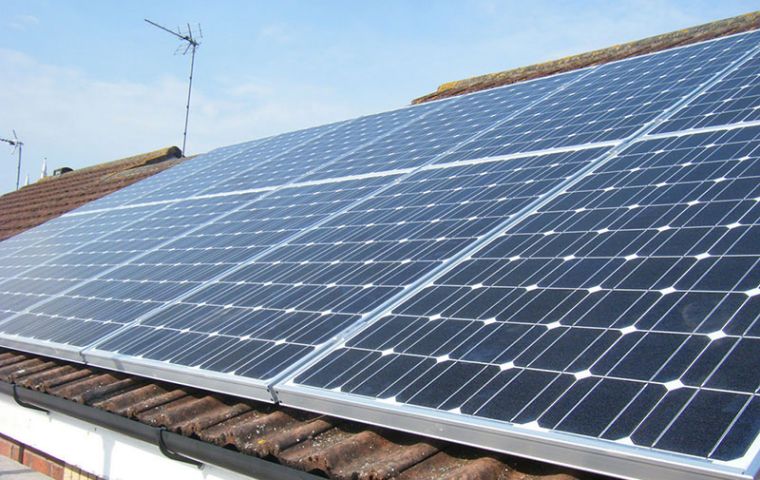MercoPress. South Atlantic News Agency
Renewable energy keeps advancing despite a drop in overall investment
 The falling cost of solar photovoltaic systems was partly responsible for a lesser sum of investment.
The falling cost of solar photovoltaic systems was partly responsible for a lesser sum of investment. Renewable energy's share of world electricity generation continued its steady climb last year despite a 14% drop in investments to 214.4 billion dollars, according to a new report released on Monday and produced by the Frankfurt School-UNEP Collaborating Centre for Climate & Sustainable Energy Finance, the United Nations Environment Program (UNEP) and Bloomberg New Energy Finance.
According to the Global Trends in Renewable Energy Investment 2014, the investment drop of 35.1 billion was partly down to the falling cost of solar photovoltaic systems. The other main cause was policy uncertainty in many countries, an issue that also depressed investment in fossil fuel generation in 2013.
Globally, renewable energy excluding large hydro accounted for 43.6% of newly installed generating capacity in 2013. Were it not for renewable, world energy-related CO2 emissions would have been an estimated 1.2 gigatonnes higher in 2013. This would have increased by about 12% the gap between where emissions are heading and where they need to be in 2020 if the world is to have a realistic prospect of staying under a two degree Centigrade temperature rise.
“A long-term shift in investment over the next few decades towards a cleaner energy portfolio is needed to avoid dangerous climate change, with the energy sector accounting for around two thirds of total greenhouse gas emissions,” said Achim Steiner, UN Under-Secretary-General and Executive Director of UNEP.
“The fact that renewable energy is gaining a bigger share of overall generation globally is encouraging. To support this further, we must re-evaluate investment priorities, shift incentives, build capacity and improve governance structures.”
“While some may point to the fact that overall investment in renewables fell in 2013, the drop masks the many positive signals of a dynamic market that is fast evolving and maturing,” he added. “This should give governments the confidence to forge a new robust climate agreement to cut emissions at the 2015 climate change conference in Paris.”
In recent years, Global Trends in Renewable Energy Investment has become the standard reference for global renewable energy investment figures. The 2014 edition will be showcased at the Bloomberg New Finance Initiative “Future of Energy Summit” in New York from 7-9 April 2014.
Ulf Moslener, Head of Research of the Frankfurt School-UNEP Collaborating Centre for Climate & Sustainable Energy Finance, agreed that the overall decline in investment dollars had been disappointing. However, he said, “foundations for future growth in the renewable energy market fell into place in 2013.”
Large hydro-electric projects were another important area of investment with at least 20 GW of capacity estimated to have come on stream in 2013, equivalent to approximately 35 billion of investment.
Although investment in renewable energy capacity, including all hydro, in 2013 was once again below gross investment in fossil-fuel power, at 227 billion compared to 270 billion, it was roughly double the net figure for investment in fossil-fuel power excluding replacement plant.




Top Comments
Disclaimer & comment rules-

-

-

Read all commentsTechnical innovation in solar energy and battery technology will make solar energy competive with fossil fuels without subsidy.
Apr 10th, 2014 - 08:43 am 0http://www.telegraph.co.uk/finance/comm ... fuels.html
… .and the vital part, storing your solar energy in an organic flow battery to use at night.
http://www.telegraph.co.uk/finance/comm ... 010714.php
Sounds promising, but may be bad news for places like the Falklands. However, with all that wind….
Capt Siler- Falklands already uses commercial non subsidised wind power to produce up to 40% of Stanley,s electrical power demand. Many farms have windpower and battery banl with just a diesel back up so we are up at the top in alternative energy I think.
Apr 10th, 2014 - 03:46 pm 0Solar power for water heating is getting more and more common also.
And how much CO2 was released making these devices, especially lithium?
Apr 10th, 2014 - 04:47 pm 0And how much is the shortfall between the energy cost of producing, transporting, erecting and maintaining the damnable windmills?
These things never repay that with the puny amount of energy they “make”.
Commenting for this story is now closed.
If you have a Facebook account, become a fan and comment on our Facebook Page!